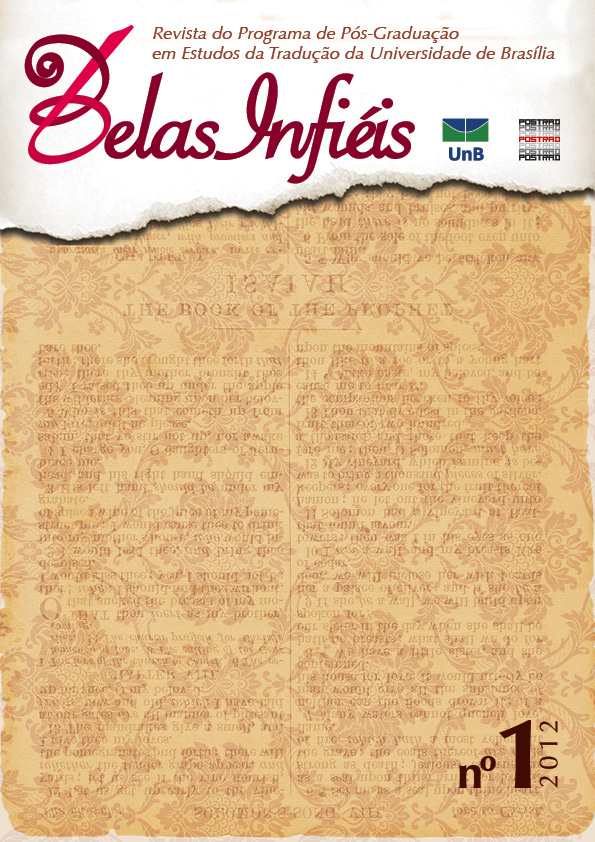OS BANDIDOS DA BABILÔNIA
DOI:
https://doi.org/10.26512/belasinfieis.v1.n1.2012.11161Palabras clave:
Bishop, poesia, tradução, Britto, BrasilResumen
“The Burglar of Babylon”, de Elizabeth Bishop, despontou como obra-prima da poesia teatralizando a criminalidade cotidiana da favela. O poema revive as antigas baladas que cantavam as façanhas de heróis e criminosos. Com um estilo acessível de narrativa que faz emergir complexidades sociais e ironia, o poema alcançou uma grande diversidade de leitores. Este artigo propõe uma análise crítica da composição do poema em sua forma e conteúdo, a fim de elucidar aspectos sutis que tangenciam essa obra, bem como apontar como as escolhas poéticas e de adaptação feitas por Paulo Henriques Britto vieram abrilhantar a obra traduzida para o português.
Descargas
Citas
ALARCÃO, Miguel. Balada. “E-Dicionário de Termos Literários de Carlos Ceia”, Disponível em <http://www.fcsh.unl.pt/invest/edtl/verbetes/B/balada.htm>. Acesso em: 6nov. 2011.
ARGOLO, José Amaral. Sparsae. Rio de Janeiro: E-papers, 2009.ARISTÓTELES. Poética. São Paulo: Abril, 1981.
BISHOP, Elizabeth. Conversations with Elizabeth Bishop. Ed. George Monteiro. Jackson: University Press of Mississipi, 1996.
_____. Poemas.Tradução Paulo Henriques Britto. São Paulo: Companhia das Letras, 1999.
_____. The Ballad of the Burglar of Babylon.Nova York: Farrar, Straus, 1968.
_____. The Complete Poems ”“1927-1979. New York: The Noonday Press, 1979.
_____. Uma arte: as cartas de Elizabeth Bishop. Org. Roberto Giroux. Trad. Paulo Henriques Brito. São Paulo: Cia. Das Letras, 1995.
BRITTO, Paulo Henriques.A Tradução para o português do metro de baladainglês. In: Fragmentos,n.34, jan.-jun. 2008. Disponível em . Acesso em set. 2011.
_____. Puzzles. Jornal Plástico Bolha, ano 2, n.13, jun. 2007. Disponível em: <http://www.jornalplasticobolha.com.br/downloads/pb13.pdf>.Acessoem 5nov. 2011.
BUENO, Eva Paulino. Retorno à Cidade Maravilhosa, ou: carro pequeno, fuzil grande.Revista Espaço Acadêmico,n.63, ago. 2006.Disponível em:<http://www.espacoacademico.com.br/063/63bueno.htm#_ftn1>. Acessoem 19nov. 2011.
CARPER, Thomas;ATTRIDGE, Derek. Meter and meaning: an introduction to rhythm inpoetry. New York: Routledge, 2003.
EAGLETON, Terry. Ideologia ”“uma introdução. São Paulo: Universidade Estadual Paulista & Boitempo, 1997.
FILHO, Leite. El caudillo: Leonel Brizola ”“um perfil bibliográfico.São Paulo: Aquariana, 2008.
GAY, Ross. The complete poems ”“by Elizabeth Bishop. In: National Book Awards Poetry Blog. Mar. 2011.Disponível em:<http://nbapoetryblog.squarespace.com/journal/2011/3/14/1970.html>.Acesso em: ago. 2011.
GÓES, Marta. A poeta dos poetas.Revista Brasileiros, n.44, mar. 2011. Disponível em:<http://www.revistabrasileiros.com.br/2011/03/23/a-poeta-dos-poetas/>. Acesso em: abr. 2011.
MARTINS, Maria Lúcia Milléo. Resenhas de traduções. Cadernos de Tradução da UFSC, Florianópolis: GT Tradução, n. 5, 2000.
OITICICA, Hélio. O herói anti-herói e o herói anônimo. In: Sopro 45. Desterro: Cultura e Barbárie, fev. 2011. Disponível em: <http://www.culturaebarbarie.org/sopro/arquivo/heroioiticica.html>.Acesso em: ago. 2011.
SCHWARTZ, Lloyd;ESTESS, SybilPittman. Elizabeth Bishop and Her Art.In: Under Discussion. Michigan: University of Michigan, 1983.
SÜSSEKIND, Flora. A geleia & o engenho: em torno de uma carta poema de Elizabeth Bishop a Manuel Bandeira. In: Papéis Colados.Rio de Janeiro: Editora UFRJ, 1993.p. 331-365.
TRAVISANO, Thomas J. Elizabeth Bishop: her artistic development.US: University of Virginia, 1989.Disponível em: <http://www.recantodasletras.com.br/teorialiteraria/96641>.Acesso em: 06nov. 2011.
VALLADARES, Licia. Passa-se uma casa. Análise do Programa de Remoção de Favelas do Rio de Janeiro.Rio de Janeiro: Zahar Editores, 1980.
Descargas
Publicado
Cómo citar
Número
Sección
Licencia
Copyright Statement
Given the public access to this journal, the texts are free to use but requires the recognition of the original authorship and initial publication in this journal to be properly stated.
The journal allows the use of works published for non-commercial purposes, including the right to submit the work to publicly accessible databases. Published contributions are the sole and exclusive responsibility of the author(s).
- When submitting papers to be evaluated by the Belas Infiéis journal, the author(s):
- Declare that the contents of the contributions are original and of their original creation, being entirely responsible for their content if there is an objection by third parties.
- Claim to be aware that they should not commit academic plagiarism.
- Declare that the manuscript has not been published, completely or partially, in Portuguese or another language. If it is a translation it should be submitted to the Translated Articles section.
- Declare that the manuscript is not being evaluated by other journals.
- Declare that the manuscript was not submitted to another journal simultaneously.
- Commit(s) to inform the journal of any kind of error or inaccuracy in their contribution (published, in evaluation or in editing) and to collaborate with the editors to make due corrections of the article (when in evaluation or editing) or erratum/retraction (after publication).
- Declare that there is no conflict of interest regarding the published work.
- Authorize its release if it is accepted for publication without any kind of monetary compensation.
- Agree to assign non-exclusive rights to publication to the magazine, remaining free to make their contribution available in other media as long as the publication of the first version in Belas Infiéis magazine is mentioned. They also authorize Belas Infiéis to assign their texts for reproduction in content indexers, virtual libraries and similar platforms.
- Maintain copyright and grant the journal the right of first publication, the work being licensed under theCreative Commons Attribution License.
- Is/Are allowed and encouraged to publish and distribute their work online after the editorial process, which may increase the impact and citation of the published work.
- Authorize the editorial team to make textual adjustments and to adapt the article to the publication rules, when necessary.



















